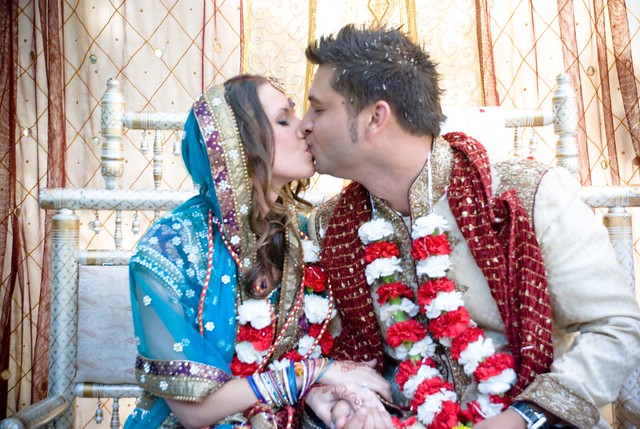
My fiance and I come from similar cultures, but we don't speak the same language. On top of that, most of our friends and family member don't speak both languages. While I'm not afraid that they will find a way to communicate by themselves, I am concerned about putting together a nice ceremony that would not involve too much repeating or constant translating.Any advice for a bilingual wedding ceremony?
– Coline
We've definitely got some advice for crafting a bilingual wedding ceremony that isn't just repeating everything verbatim. We're going to harness the power of the program, the signage, your wedding website, your wedding schedule, and your wedding party to make sure everyone knows what's going on while not getting bored listening to one language the whole time. Let's get to the bilingual wedding ceremony tricks:
Include both languages in the program
Bilingual programs (like these in English and Catalan!) are a great way to give details about what's going on in the ceremony without having to translate everything on the spot. Here are a couple of examples from real offbeat weddings:
Danielle & Gonzalo's bilingual dance party wedding:
My husband is Mexican-American, and so it was important to us to be married by someone who spoke Spanish. Luckily a dear friend, who is bilingual, was willing to get ordained. During the ceremony, we included readings in Spanish and a traditional ritual called The Lasso, which is like a giant rosary that gets wrapped around the couple's shoulders, and symbolizes unity. It was given to us by Gonzalo's aunt, blessed by our friend, and placed on us by our wedding compadres. It was one of the most beautiful moments of the ceremony. My family is Irish and my sisters also read a traditional Irish blessing.
Chantal & Stefan's rocking South African wedding:
We decided on a Christian ceremony, to keep our parents happy (I'm actually pagan, but they don't know it yet). We found the greatest pastor who was perfectly ok with marrying a non-Christian couple – he even suggested a bilingual ceremony (Afrikaans/English), as it would be more discreet (and much shorter) than the traditional Christian ceremony. In the end, it was a beautiful ceremony, and I'm not sorry we didn't go for a handfasting or a plain civil ceremony.

Use your wedding website judiciously
Your wedding website has essentially unlimited space to explain, digress, and extrapolate all about your traditions, faiths, and rituals that might be going on during your ceremony and reception. You may not have time to be explaining everything in both languages, so offering background information on your wedding website is a life-saver. Read how reader Spaceviking handled this on her wedding website:
This page will be how 80% of my (very Catholic) family will have the “Surprise! I've converted to a different religion!” news broken to them, so it's important. I think I've covered all the serious points and details clearly, addressed concerns respectfully, and peppered in enough humor, so it's not a total srs bns snore-fest that has a completely different tone from the rest of the FAQs. Plus, I'm hoping I really nailed ‘polite but firm.'
Make your signage bilingual
Whether you're telling guests where to sit, who's in the wedding party, or where to head next, make your larger-scale signage bilingual. You can explain things in your wedding website, but you can't easily explain where the photo booth or food is without a sign. Prioritize those elements to have both languages.
Find a bilingual officiant
Finding a bilingual officiant probably won't be the real challenge here, especially if you have a friend or family member become ordained. The trick here is to make sure you're not repeating every line in two languages (unless it's American Sign Language, of course, and can be signed simultaneously!).
Try to find a balance between the language the majority of your guests speak and then adding in translations on the most important parts. Let your program and wedding website fill in the rest of the blanks.
Feel free to pepper your vows with bilingual elements, too, especially if the languages mean something extra for each element of the vows.

Nominate a bilingual wedding party member to help guests
If you have someone close to you or in your wedding party who speaks both languages, ask them to help you herd some cats when it's time to move locations or if someone looks a little lost. Having someone keeping an eye on those who aren't understanding whichever language seems to dominating will be helpful.
Keep readings and speeches short
Since some guests won't understand the readings and speeches, try to keep them relatively short to prevent boredom from setting in. If you'll be having speeches in both languages, try to alternate them so that there isn't a long span of one language dominating the time slot.

Use songs from both languages
For your processional and other key music moments, feel free to use songs that represent both cultures/languages. It should help make your guests feel included in the elements of the ceremony and keep you rocking out to your own favorites.
Provide language tips at reception tables
To help break the ice, you could provide language tip cards to help guests introduce each other. Write out short phrases like “hello, how are you,” “You look lovely,” and “congratulations” phonetically so that they can strike out and give the other language a go and make bonds with their new relations.
Alright bilingual offbeat couples: what tricks do you have for accommodating multiple languages?










We actually have three languages: husband is Spanish, I’m German, and we have a pretty multi-national guest list meaning that we also need English to communicate with some of our guests who speak neither German nor Spanish.
Our invites and RSVP cards were trilinugal and we were actually surprised how easy it was to make that work. We used a triptych kind of layout that left us with six sides to write on, which proved to be plenty of space for all we needed to say. Our wedsite is partially trilingual: all the most important content is in three languages, but we kept some parts in English only, particularly the advice for our out of town guests.
As for the ceremony, we’ve already done the paperwork and so were quite free to play with the set-up. We have two friends officiating who between them can cover the three languages. We decided to keep the language-to-language ratio relatively even, so as to make sure those people who only understand one of the languages won’t miss out on too much. For our I do’s, for instance, I will say them in German, husband-to-be will say them in Spanish, and then we have a joint section in English. We’re writing them ourselves. Since this means that they will be only partially understood by our families, we’ll translate them afterwards and put them in the photo albums we’re planning to give to them.
And we have a multi-lingual team of guest-wranglers to help us get everyone from A to B. It’s going to be interesting, and I hope it’ll work 🙂
Wow. I like your ideia. I have the same issue. My fiancé is Chinese and I’m Brazilian but the wedding is going to be in California in English. My family only speak Portuguese and his family only speak Mandarim. I was looking for a way to solve this issue then everybody could enjoy the wedding.
So creative i love it!
Thank you for featuring my Save the Date 🙂